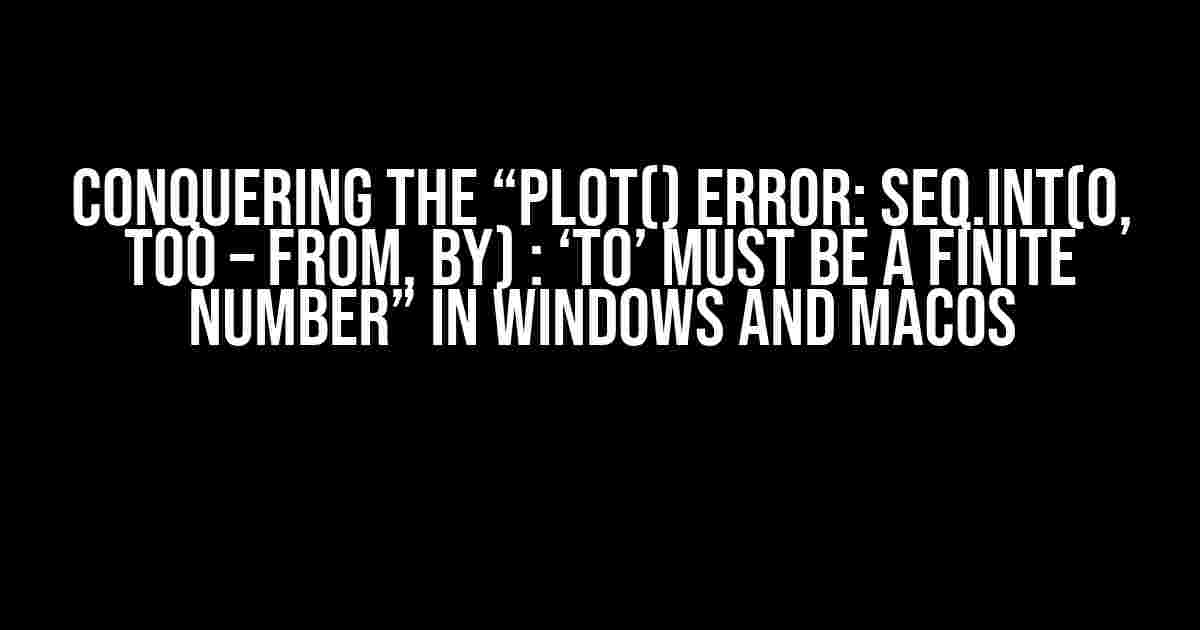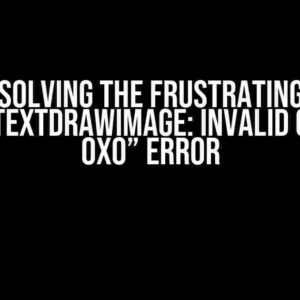Welcome to the fascinating world of data visualization, where the thrill of creating stunning plots and charts can quickly turn into frustration when faced with the infamous “plot() error: seq.int(0, to0 – from, by) : ‘to’ must be a finite number” error in Windows and MacOS. Fear not, dear reader, for we’re about to embark on a journey to conquer this error and get you back to creating breathtaking visualizations in no time!
What’s behind the error?
In the world of R programming, when you create a plot, you’re essentially telling R to create a sequence of numbers from a starting point (“from”) to an ending point (“to”) with a specified increment (“by”). This sequence is used to create the x-axis of your plot. The error occurs when the “to” value is not a finite number, i.e., it’s either infinite or NaN (Not a Number).
Common scenarios leading to the error
So, how do you end up with an infinite or NaN value for the “to” argument? Here are some common scenarios to watch out for:
- Infinite values in your data: If your data contains infinite values, these will propagate to the “to” argument, causing the error. This can happen when you have missing or erroneous data.
- NaN values in your data: Similarly, if your data contains NaN values, these will also cause the error.
- Mismatched data types: When you mix different data types, such as numeric and character, R can get confused, leading to an infinite or NaN value for the “to” argument.
- Incorrect function usage: Using the plot function with incorrect arguments or in the wrong context can also lead to the error.
Solutions to conquer the error
Now that we’ve identified the culprits, let’s dive into the solutions to overcome the “plot() error: seq.int(0, to0 – from, by) : ‘to’ must be a finite number” in Windows and MacOS:
Solution 1: Check and clean your data
A crucial step in data visualization is to ensure your data is clean and free of errors. Use the following techniques to detect and remove infinite and NaN values:
# Load the necessary libraries
library(tidyverse)
# Create a sample dataset with infinite and NaN values
df <- data.frame(x = c(1, 2, Inf, 4, 5, NaN, 7), y = runif(7))
# Use the following code to detect and remove infinite and NaN values
df_clean <- df %>%
drop_na() %>%
replace_infinite()
# Define a function to replace infinite values
replace_infinite <- function(x) {
x[is.infinite(x)] <- NA
return(x)
}
Solution 2: Verify data types and convert when necessary
Ensure that your data types match the required format for the plot function. Use the following techniques to convert data types:
# Convert character data to numeric
df$x <- as.numeric(as.character(df$x))
Solution 3: Use the correct plot function and arguments
Double-check that you’re using the correct plot function and arguments. Refer to the R documentation or seek help from online resources if needed:
# Use the correct plot function and arguments
plot(df_clean$x, df_clean$y, xlim = c(0, 10), ylim = c(0, 1))
Solution 4: Use alternative plotting libraries
If you’re still encountering issues, consider using alternative plotting libraries like ggplot2, which can be more forgiving when dealing with errors:
# Load the ggplot2 library
library(ggplot2)
# Create a ggplot object
p <- ggplot(df_clean, aes(x = x, y = y)) +
geom_point() +
theme_classic()
# Print the plot
print(p)
Common pitfalls to avoid
As you continue on your data visualization journey, keep an eye out for the following common pitfalls that can lead to the “plot() error: seq.int(0, to0 – from, by) : ‘to’ must be a finite number” error:
- Not checking for infinite and NaN values: Failing to remove or replace these values can lead to the error.
- Ignoring data type mismatches: Mixing data types can cause the error, so ensure you’re using the correct data types for your plot.
- Using incorrect plot function arguments: Incorrectly specifying the “from”, “to”, and “by” arguments can lead to the error.
Conclusion
With these solutions and precautions in mind, you’re now well-equipped to conquer the “plot() error: seq.int(0, to0 – from, by) : ‘to’ must be a finite number” error in Windows and MacOS. Remember to always check and clean your data, verify data types, use the correct plot function and arguments, and consider alternative plotting libraries when needed. Happy plotting!
| Scenario | Solution |
|---|---|
| Infinite values in data | Use drop_na() and replace_infinite() functions to remove infinite and NaN values |
| NaN values in data | Use drop_na() and replace_infinite() functions to remove infinite and NaN values |
| Mismatched data types | Verify data types and convert when necessary using as.numeric() or as.character() functions |
| Incorrect function usage | Use the correct plot function and arguments, referring to R documentation or online resources when needed |
By following these guidelines, you’ll be able to overcome the “plot() error: seq.int(0, to0 – from, by) : ‘to’ must be a finite number” error and continue creating stunning visualizations in Windows and MacOS. Happy plotting!
Frequently Asked Question
Getting stuck with the “plot() error: seq.int(0, to0 – from, by) : ‘to’ must be a finite number” error in Windows and Macos? Don’t worry, we’ve got you covered! Here are some frequently asked questions and answers to help you troubleshoot the issue.
What is the “plot() error: seq.int(0, to0 – from, by) : ‘to’ must be a finite number” error?
This error occurs when the ‘to’ value in your plot function is set to Infinity or -Infinity, which is not a valid input for the seq.int function. This function requires a finite number to generate a sequence of values.
What causes the “plot() error: seq.int(0, to0 – from, by) : ‘to’ must be a finite number” error?
This error can be caused by a variety of factors, including incorrect data input, faulty code, or even a bug in the R programming language itself. In most cases, it is due to a programming mistake, such as passing Infinity or -Infinity as an argument to the plot function.
How do I fix the “plot() error: seq.int(0, to0 – from, by) : ‘to’ must be a finite number” error?
To fix this error, you need to ensure that the ‘to’ value in your plot function is a finite number. Check your code for any instances of Infinity or -Infinity and replace them with a valid finite number. You can also try to debug your code by printing the values of ‘to’, ‘from’, and ‘by’ to see if they are what you expect.
Can I use the “Inf” or “-Inf” values in my plot function?
No, you should avoid using “Inf” or “-Inf” values in your plot function, as they are not valid inputs for the seq.int function. Instead, use a finite number that makes sense for your specific use case. If you need to plot data that extends to infinity, consider using a log scale or a different visualization approach.
Is the “plot() error: seq.int(0, to0 – from, by) : ‘to’ must be a finite number” error specific to Windows and Macos?
No, this error is not specific to Windows and Macos. It can occur on any platform that uses the R programming language, including Linux and other operating systems. The error is caused by the seq.int function’s requirement for a finite ‘to’ value, which is a fundamental aspect of the R language.


![Demystifying MiniflareCoreError [ERR_RUNTIME_FAILURE]: A Step-by-Step Guide to Resolving the “Workers Runtime Failed to Start” Error Demystifying MiniflareCoreError [ERR_RUNTIME_FAILURE]: A Step-by-Step Guide to Resolving the “Workers Runtime Failed to Start” Error](https://terisa.hkhazo.biz.id/wp-content/uploads/sites/274/2024/07/demystifying-miniflarecoreerror-err_runtime_failure-a-step-by-step-guide-to-resolving-the-workers-runtime-failed-to-start-error-with-text-300x300.jpg)

